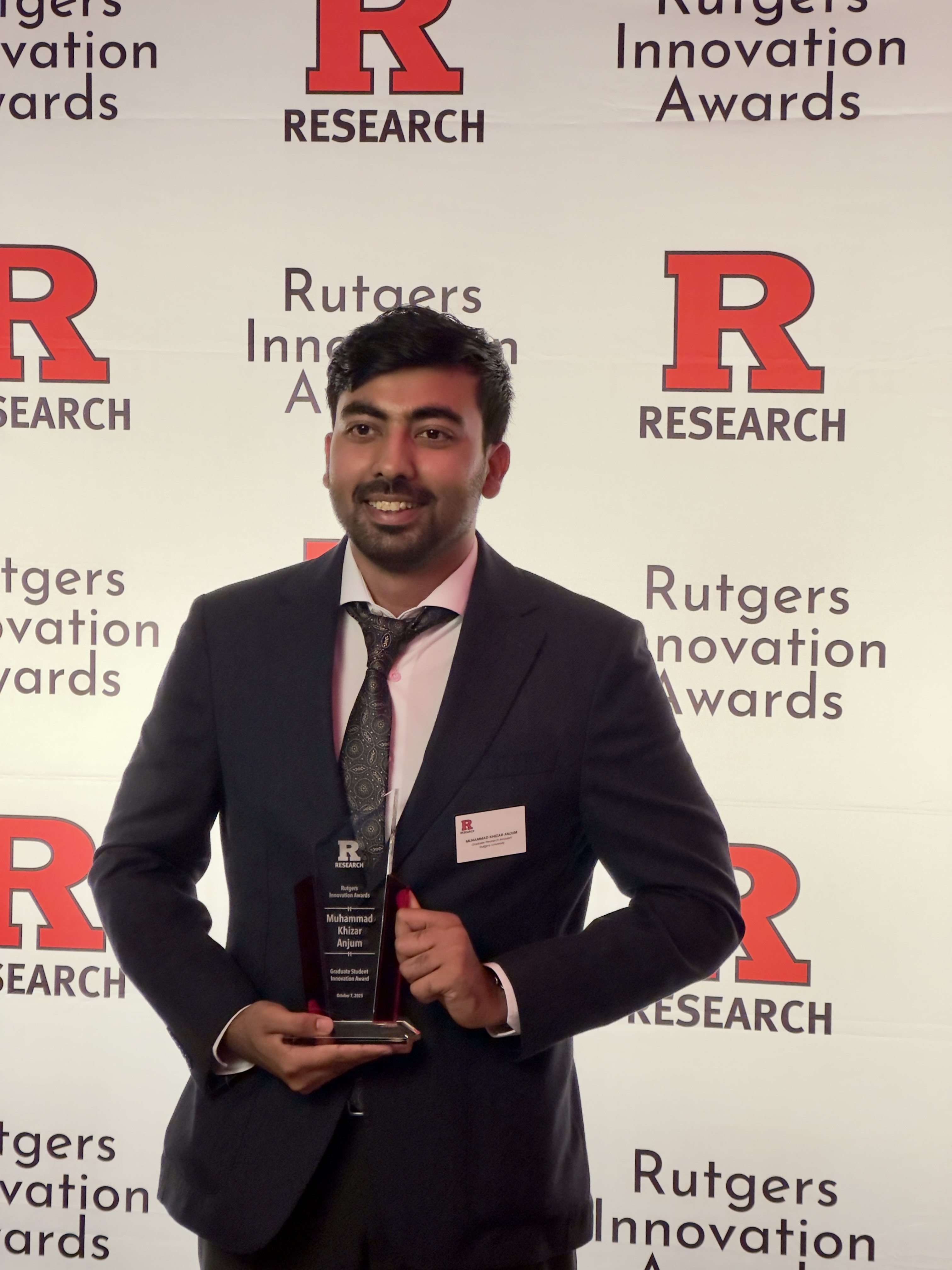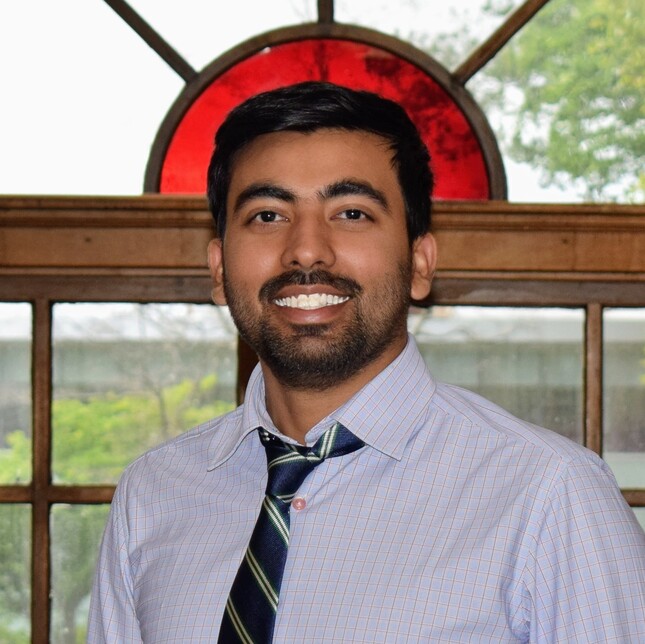Muhammad Khizar Anjum Honored with Graduate Student Innovation Award
The Office for Research celebrated the 2025 Rutgers Innovation Awards, honoring this year’s recipients alongside peers, industry leaders, and university leadership on October 8, 2025, in the President’s Tent on the College Avenue Campus. Now in its second year, the awards recognized researchers whose breakthrough ideas, processes, or technologies have the potential to create economic value for the state of NJ and benefit society. Rutgers Executive Vice President for Academic Affairs and Chief Academic Officer Keena Arbuthnot and Senior Vice President for Research Michael Zwick presented the awards, which also recognized Rutgers inventors who were issued U.S. patents in fiscal year 2025, innovators with licensed non-patent intellectual property, and Technology Transfer Trainees who had completed their year-long appointments. `

The event showcased the growing culture of innovation and entrepreneurship at Rutgers. The honorees represented a wide range of disciplines and embodied Rutgers’ commitment to advancing research with real-world impact through collaboration among faculty, students, and industry partners. Among this year’s honorees was Muhammad Khizar Anjum, a doctoral student in the School of Engineering at Rutgers–New Brunswick, who received the Graduate Student Innovation Award. His research reflects the creativity and drive of School of Graduate Studies (SGS) students who push the boundaries of knowledge and seek solutions to real-world challenges.
In Conversation with Muhammad Khizar Anjum
Muhammad Khizar Anjum’s award-winning research introduces an analog computing architecture that uses anisotropic diffusion in passive element lattices to perform neural network computations at ultra-low power levels—making batteryless, continuously powered wearable health monitors possible. Developed in the Cyber-Physical Systems (CPS) Lab under the mentorship of Dr. Dario Pompili, his work bridges complex theory and practical implementation, overcoming key challenges in translating mathematical models into working analog hardware. This innovation could one day enable continuous monitoring for millions of epilepsy and cardiovascular patients, especially in settings where power access is limited. Looking ahead, Anjum hopes to move from theoretical validation to prototype development and eventual commercialization, contributing not only to healthcare but also to the broader field of ultra-low-power AI. His advice to fellow SGS students: challenge assumptions, seek supportive mentors, focus on real-world constraints, and stay grounded in the human impact of their research.

What is the core innovation of your project, and what problem does it solve?
Our innovation uses anisotropic diffusion in passive element lattices to perform neural network computations at ultra-low power levels, enabling batteryless wearable health monitors powered entirely by harvested energy. This solves the fundamental limitation of current health wearables—battery dependency—which prevents continuous monitoring of life-threatening conditions like epilepsy and cardiovascular diseases, making truly persistent health tracking practically feasible for the first time.
What Rutgers people, experiences, courses, labs, or resources most shaped this work?
This work was shaped entirely by my experience in the CPS (Cyber-Physical Systems) Lab under the mentorship of my PhD advisor, Dr. Dario Pompili. Dr. Pompili worked closely with me to make this analog-digital hybrid system possible, and his guidance has been instrumental in pushing the boundaries of what we can achieve with analog neural network architectures. The collaborative environment in the CPS Lab has been essential for developing and refining these innovative approaches to ultra-low power computation.
What was the toughest challenge you faced during the project, and how did you overcome it?
The toughest challenge was bridging the gap between theoretical principles of anisotropic diffusion and practical implementation in analog hardware. Specifically, we needed to prove mathematically that controlled conductances in passive element lattices could perform arbitrary convolution operations equivalent to digital neural networks, then translate that theory into a working architecture. We overcame this by developing a novel modification to traditional lattice connections using CMOS analog adders to create summation-based connections between elements instead of direct connections. This architectural innovation provided the degrees of freedom necessary to implement arbitrary convolution kernels while maintaining ultra-low power operation, ultimately enabling our 4-degree-of-freedom 2D convolution capability.
What impact do you hope this innovation will have in the next 1–3 years?
In the next 1–3 years, I hope to see this technology move from theoretical validation to prototype development and initial commercialization. We're currently working in the CPS Lab on commercializing a similar neural network architecture we previously designed, and once that's completed, we plan to work toward making this anisotropic diffusion-based system a reality as well. The immediate societal impact I envision is enabling continuous, batteryless health monitoring for the approximately 96 million epilepsy patients worldwide and millions more with cardiovascular diseases. By eliminating battery constraints, we can make sophisticated health monitoring accessible in resource-limited settings and enable truly persistent monitoring that could prevent life-threatening events through early detection. Beyond healthcare, this technology could advance the broader field of ultra-low power AI, enabling intelligent edge computing in environments where power is scarce.
What advice would you give other SGS graduate students who want to turn research ideas into real-world impact?
First, don't be afraid to challenge fundamental assumptions in your field. Our breakthrough came from questioning why neural networks must be digital and exploring whether analog physics could perform the same computations more efficiently. Second, seek out mentors who share your vision for translational research. Having Dr. Pompili's support was crucial for pursuing this unconventional approach. Third, think about the real-world constraints your solution must address from the beginning. We didn't just design a better algorithm; we designed around the fundamental constraint of power availability in wearable devices. Fourth, be prepared for the long journey from theory to practice, i.e., proving mathematical equivalence is just the first step, and implementation reveals challenges you never anticipated. Finally, stay connected to the actual problem you're solving. Knowing that 96 million epilepsy patients could benefit from continuous monitoring kept me motivated through the difficult technical challenges. Real-world impact comes from maintaining focus on the people whose lives your work could improve.
Stories like Muhammad’s reflect the spirit of Rutgers graduate students across disciplines who are advancing discovery with purpose. Through their research, creativity, and perseverance, SGS students are driving innovation that strengthens New Jersey’s economy, contributes to national competitiveness, and addresses urgent challenges in health, technology, and society.